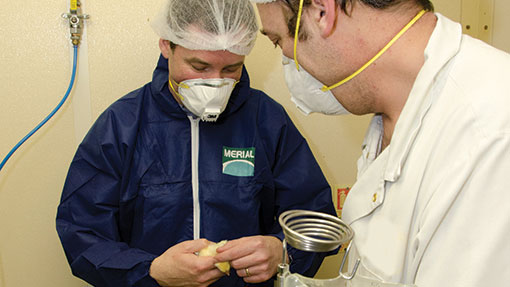Vaccines and biosecurity counter Gumboro in poultry

Gumboro, or infectious bursal disease as it is also known, continues to be a serious threat to the global poultry industry.
First discovered in the USA in the 1960s, Gumboro virus causes severe impairment in chickens due to the destruction of part of the immune system called the bursa of Fabricius. This results in an inability to mount a good antibody response to other bacteria and viruses.
Gumboro virus is very resistant in the environment and infections typically damage the bursa when chickens are between three and eight weeks of age. Clinical effects include immunosuppression, watery diarrhoea and mortality of up to 60% in the most virulent cases.
In its first few weeks, the chick is protected by antibodies from the mother hen, passed to the embryo chick in the yolk. But by three weeks this immunity will be gone.
It is important that any vaccination programme minimises the “immunity gap” between protection from maternally derived antibodies (MDA) and the young chick producing its own protective antibodies in response to vaccination.
Vaccine development
The first generation of Gumboro vaccines were “modified live vaccines” administered through drinking water.
But the timing of these treatments is a particular problem, according to Sjaak de Wit from the European College of Poultry Veterinary Science. If they are given too early in a bird’s life they will be neutralised by MDA, he told a recent Merial Animal Health avian forum in Paris. Vaccination given later on increases the chance of chickens being unprotected against Gumboro disease during the “immunity gap”.
See more: Managing the modern broiler: Days seven to 21
Administration by drinking water also comes with a number of other challenges, such as the need to keep live vaccines cool and out of sunlight while being transported. Chlorine in mains water, or iron in borehole water, damages live vaccines, and a water stabiliser is essential.
Drinking lines need to be clean, free of sanitisers and birds must have sufficient access to water containing the vaccine. Finally, for successful flock vaccination, all birds must drink the vaccinated water to prevent rolling infections with vaccine virus.
The second generation of Gumboro vaccines were “immune complex vaccines”, which are composed of a live vaccine strain bound to antibodies. These can be administered at the hatchery. But once the level of maternally-derived immunity begins to fall, the virus begins to replicate.
Generally this starts when chicks are between two-and-a-half and four weeks old. As a result, the immunity gap can still be an issue. These vaccines can also cause significant bursal damage and immunosuppression.
Vectored vaccines
The current generation of vaccines are known as “HVT-vectored vaccines” and these benefit from cutting-edge gene technology.
They can be given “in ovo” or at day old in the hatchery. They replicate in the chick’s cells without being affected by the maternal Gumboro antibodies and do not damage the bursa in the process.
Research presented at the Paris forum compared a live, hot Gumboro vaccine given to commercial brown pullets at day 21 in the drinking water, and Merial’s vectored vaccine, Vaxxitek HVT+IBD, administered subcutaneously at day old in the hatchery.
The pullets were then challenged at 28 days with a very virulent IBD virus.
The trial showed that both vaccines provided full clinical protection, but in the live Gumboro vaccine group there were severe lesions in the bursa. The Vaxxitek® vaccination group, in contrast, had no lesions and the birds were significantly heavier at 28 and 38 days of age.
These results are consistent with the experience of Neville Pennington of Oaklands Farm Eggs, who told a previous forum that Oaklands had struggled with Gumboro disease, leading to poor chick uniformity and subsequent variable egg production.
According to Mr Pennington, using the vectored vaccine at the hatchery had a number of advantages, including a greater ability to audit its effectiveness by serology. Its introduction resulted in less stress on the birds by removing all on-farm live Gumboro treatments, more even bodyweights and improved overall bird health.
Biosecurity
Helen Houghton, Merial Animal Health avian manager and veterinary adviser, says it is clear that considerable progress has been made in the evolution of vaccines.
“However, as with all infectious diseases in poultry, we also need to ensure the highest levels of biosecurity are maintained.
“This should include controlled access and footbaths at site and house entrances. The best possible cleaning and disinfection procedures should be put in place and, if possible, a reasonable period of downtime allowed between flocks.”
